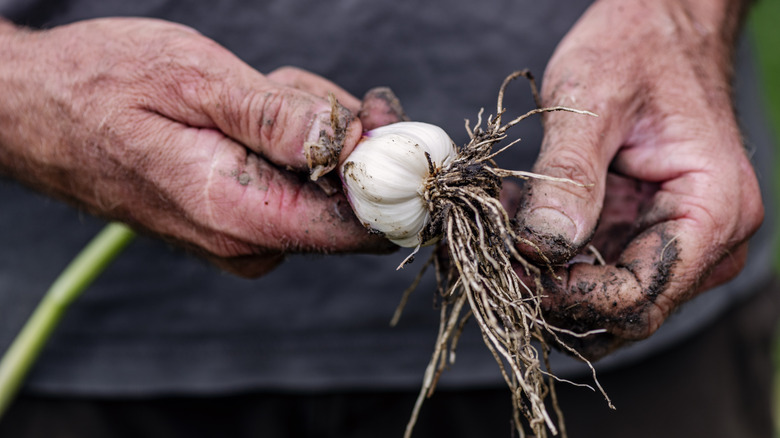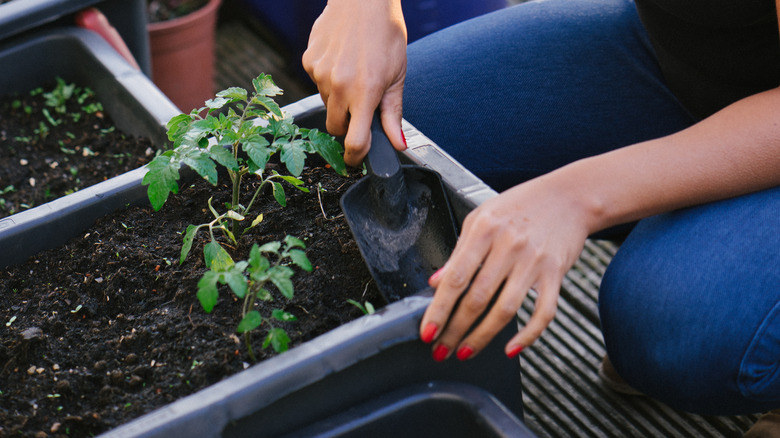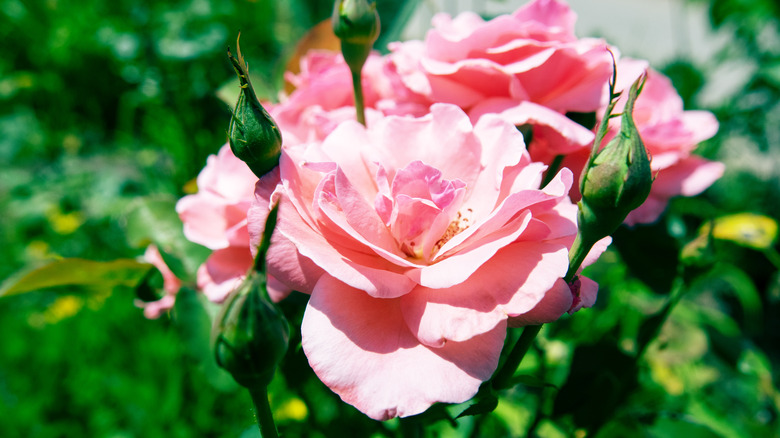Why Sage And Garlic Aren't Friendly In The Garden
Garlic and sage are both common ingredients to use in your kitchen and combine when cooking — garlic and sage brown butter sauce is a classic Italian pasta recipe — but just because they go well in your culinary dishes, it doesn't mean they will play nicely if you grow them together in your garden.
You should be wary of planting garlic near different herbs and plants in your garden. Garlic is known, not only to stunt the growth of sage if planted nearby but also parsley and other plants. This is because the soil contains nutritional resources that both the garlic and these herbs need, which means there won't be enough to go around and may result in an inadequate crop at harvest time. There's nothing more frustrating than having to peel and dice tiny garlic cloves, and herbs that don't grow in abundance are just a waste of time and space in your garden.
As well as being physically growth-stunting, you'll also notice a negative impact on flavor. Sage is known for its aromatic qualities in cooking, which may be reduced if you plant sage next to garlic. Conversely, sage can also overpower and ruin the variety and versatility of flavors we enjoy from garlic in our cooking, which is a real shame. This doesn't mean you can't grow both garlic and sage in your garden though. Keep reading to find out how, and what you can plant alongside garlic and sage instead.
How to keep sage and garlic separate in the garden
Even though you shouldn't plant these herbs in the same spot, you can still enjoy a large variety of incompatible herbs and plants in your garden using container gardening or raised garden beds. These are really effective ways of keeping your plants separate so that you can provide each with the right kinds of soil, fertilizers, and watering routine for their specific nutritional needs. It also means you can enjoy a beautiful variety of plants, flowers, herbs, and veggies in your garden, and they'll also enjoy the benefits that each has to bring to the environment. For example, garlic could be the key to keeping pesky crows out of your garden, saving other plants from being pecked or pooped on! Garlic can also be used as a pest control to repel plant pests, whereas sage attracts pest predators.
If much of your garden is taken up with patio space, containers will significantly increase your garden's growing potential. Sage bushes are perfect for container gardening, as they have fairly shallow roots. You will mainly have to consider the width of the plant once it is fully grown. Garlic is also happily grown in pots, with the size of the pot depending on how many cloves you want to plant. As a guide 3-6 cloves will do well in a 20 centimeter container, but go for a 25 centimeter pot if you want to plant up to 10 cloves. The roots will enjoy a pot that is about 15 centimeters deep.
What to plant next to garlic and sage instead
If you have large flower beds and want to make the most of your space, or you simply want to plant in the ground, we have some tips to make sure you plant friendly companion plants directly adjacent to your garlic and sage. Garlic in particular is a friend and hero to many garden plants, being such a powerful pest deterrent, and repelling annoying fungus gnats, notorious aphids, and spider mites. It also helps with other bugs such as snails, cabbage looper, and even large mammals such as rabbits and deer. Did you know that garlic also contains sulfur that acts as a natural fungicide protecting neighboring plants from disease? Some great companion plants that will benefit from being planted next to garlic are tomatoes and peppers, brassicaceae like broccoli and cabbage, carrots, dill, and spinach.
Similar to garlic, sage can also be a great pest deterrent due to the highly scented leaves that most caterpillars, snails, and other bugs will turn their noses up at. If you're a rose-loving gardener you'll be pleased to discover that roses and sage make ideal companion plants. As an added bonus, sage will actually attract predators, like hoverflies, parasitic wasps, green lacewings, and ladybugs, that'll chase pests out of your garden and also feed on aphids. Some of these insects are also great pollinators which are perfect for flower gardens.


